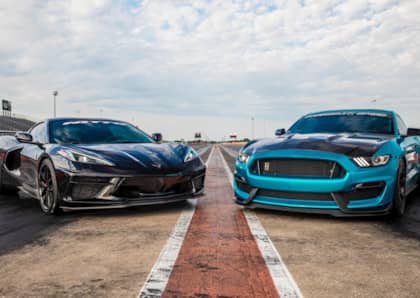No-Lift Shift Systems 101: Keeping Your Foot On The Floor While Rowing The Gears
Back in the golden days of the original muscle car era, drag racers seeking that extra hundredth of a second would experiment with 'power shifting.' This no-lift shift required drivers to move from one gear to the next without taking their foot off the gas, with the idea being that the engine would remain in the proper rev range for the next cog with no loss of power.
While this strategy may or may not have resulted in quicker ETs, it definitely wreaked havoc on delicate transmission synchros that couldn't handle the mash-and-bash of constant full-throttle power application. It also had the nasty tendency of frying the clutch as beginners struggled to stab on and off the pedal quick enough to avoid overheating it. As such, it was unpopular with anyone unwilling to risk having to walk home a winner.

Decades later, no-lift shifting has come back into the spotlight thanks to automotive technology that finally makes power shifting less of a mechanical liability. In fact, not only has the aftermarket embraced the no-lift shift, but there are even a few OEMs willing to make it standard equipment on their high performance models—with a full warranty to back up any 'oopsies' that might occur.
How Does It Work?
What makes the no-lift shift a safe propositions today compared to the gamble-your-drivetrain dice roll it once was? In a word, software. Now that engine controls have advanced to the point where nearly every aspect of how a motor operates can be individually controlled, automotive engineers have found clever ways to protect you from yourself when shifting a manual transmission as quickly as possible.

The secret lies in the ability to interrupt spark to your motor when it detects that the clutch and the accelerator have been pressed at the same time. Once the vehicle's ECU receives the signal that the clutch pedal has been activated, it cuts the ignition—effectively 'lifting' for you—until the shift has been completed, allowing you to keep the gas mashed.
Why Not Lift?
At first it might sound as though there's no real advantage to a no-lift shift system if it's effectively doing the same thing a human driver would do in backing off the revs during a gear change. While the principle is the same, the major difference is the speed at which the cut-out occurs—mere milliseconds under computer control versus the much more extended wrist-and-ankle ballet that would have to occur otherwise. In actual practice, it's almost as though no lift occurred whatsoever, with a measurable improvement in straight-line acceleration as a result.

It's clear that there are slivers of a second to be saved if you don't have to lift off the gas when swapping cogs in a manual transmission. What's even better about a properly-executed no-lift shift system is that in a turbocharged car, the briefest of ignition interruptions means that boost doesn't drop in-between gears. This can dramatically improve the power provided by a small-displacement turbo motor, as there's no need to wait for the snail to spool back up as the revs climb.
Turbos First, The Rest Will Follow
It's no coincidence, then, that the first factory-installed no-lift shift systems were offered in exactly these types of vehicles. In the early 2000s, both the Chevrolet Cobalt SS and the Chevrolet HHR SS would offer no-lift functionality to go with their 2.0-liter turbo four-cylinder drivetrains. More modern sport compacts have also used variations on the system, such as the Ford Focus RS which doesn't require that the driver lift when shifting from first to second gear after a launch control-assisted start.

On the muscle side of the equation, General Motors also leads the way in offering a no-lift shift system on many models of the Chevrolet Camaro as well as the C7-generation Chevrolet Corvette. Rare manual versions of the Buick Regal GS and Cadillac ATS-V sports sedans also provided the feature, as well as the second-generation Cadillac CTS-V. Ford lovers have long had a factory no-lift shift option for the Mustang in the form of the Blue Oval's Power Packages (PP1, PP2, PP3) available from Ford Performance.

On the aftermarket side, there are many different no-lift shift options available from a wide range of manufacturers. One of the more popular is the WOT Box from N2MB, which wires in to the vehicle's ignition system so that it can provide the engine cut-out required. These devices are easy to install, and work with almost any electronically-controlled engine management system.
Learning Curve
While a no-lift shift system is far less damaging to your drivetrain than a traditional power shift, it's not foolproof, and you should still endeavor to shift as smoothly as possible, and as quickly as possible, when using one. There's also fuel wash to consider as the cylinders fill with gasoline that doesn't get burned, which could potentially contaminate engine oil. If you use your no-lift feature on a regular basis, you'll want to keep an eye on your oil, and potentially change it more regularly than you would under normal driving.

It's also true that it takes more than a bit of practice to get used to the no-lift concept. Any experienced driver's brain is going to be screaming for the right foot to back off when attempting to shift at high rpm, and ignoring that survival instinct and learning to shift with your left foot and right hand only is definitely a learning curve. Once you have it mastered, however, you'll potentially be rewarded with a new personal best at the strip.
Looking for more drag racing tips? Check out our primer on the quarter mile here.











